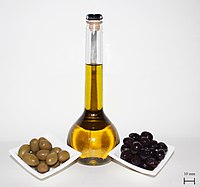
Photo from wikipedia
Mislabeling of olive oil with respect to its geographical origin is a frequently encountered fraud. Although according to European Regulation (EU) No 29/2012 it is mandatory to declare the geographical… Click to show full abstract
Mislabeling of olive oil with respect to its geographical origin is a frequently encountered fraud. Although according to European Regulation (EU) No 29/2012 it is mandatory to declare the geographical origin of an olive oil on the label, no generally accepted analytical method exists to verify this labeling. As Italy, Greece, and Spain are the main producing countries in the Mediterranean Area, the aim is to develop an analytical method that allows classification of these three origins and which can be reliably applied to routine samples. A protocol for the extraction and subsequent ¹H‐NMR measurement of the polar fraction of olive oil is developed and applied to a large number of authentic reference samples. A classification model is developed which obtains 96% of correct classification during cross‐validation. The method is being routinely applied for testing commercial off‐the‐shelf olive oils, and its accuracy is continuously verified. Practical Applications: In addition to checking the geographical origin of an olive oil, the developed protocol allows to analyze the polar constituents of an olive oil in great detail with little effort, which should prove useful also for other applications, for example, quantitation of phenols or detection of admixtures with other vegetable oils.
Journal Title: European Journal of Lipid Science and Technology
Year Published: 2019
Link to full text (if available)
Share on Social Media: Sign Up to like & get
recommendations!